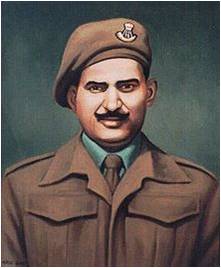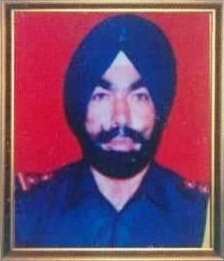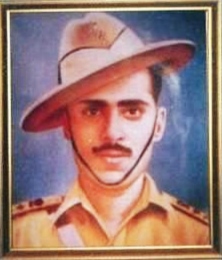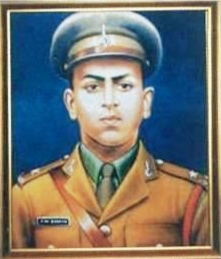
The Jat Regiment is an infantry regiment of the Indian Army, of which it is one of the longest-serving and most decorated regiments. The regiment has won 19 battle honours between 1839 and 1947, and post-independence it has won five battle honours, including 2 Victoria Cross, 8 Mahavir Chakra, 8 Kirti Chakra, 34 Shaurya Chakras, 39 Vir Chakras and 170 Sena Medals. During its 200-year service history, the regiment has participated in various actions and operations in India and abroad, including the First and the Second World Wars. Numerous battalions of the Jat Regiment, including the 14th Murray's Jat Lancers, fought in the First World War.

The Ashoka Chakra is India's highest peacetime military decoration awarded for valor, courageous action, or self-sacrifice away from the battlefield. It is the peacetime equivalent of the Param Vir Chakra (PVC) and is awarded for the "most conspicuous bravery or some daring or pre-eminent valour or self-sacrifice" other than in the face of the enemy. The decoration may be awarded either to military or civilian personnel.

The Sikh Regiment is an infantry regiment of the Indian Army. Sikh regiment is the highest decorated regiment of the Indian Army and in 1979, the 1st battalion was the Commonwealth's most decorated battalion with 245 pre-independence and 82 post-independence gallantry awards, when it was transformed into the 4th battalion, Mechanised Infantry Regiment. The first battalion of the regiment was officially raised just before the partial annexation of the Sikh Empire on 1 August 1846, by the British East India Company. Currently, the Sikh Regimental Centre is located in Ramgarh Cantonment, Jharkhand. The Centre was earlier located in Meerut, Uttar Pradesh.

The KirtiChakra is an Indian military decoration awarded for valour, courageous action or self-sacrifice away from the field of battle. It may be awarded to civilians as well as military personnel, including posthumous awards. It is the peacetime equivalent of the Maha Vir Chakra. It is second in order of precedence of peacetime gallantry awards, comes after Ashoka Chakra and before Shaurya Chakra. Before 1967, the award was known as the Ashoka Chakra, Class II.

Subedar Joginder Singh Sahnan, PVC, was an Indian Army soldier who posthumously received India's highest military gallantry award, the Param Vir Chakra. Singh joined the British Indian Army in 1936 and served in the 1st battalion of the Sikh Regiment. During the 1962 Sino-Indian War, he was commanding a platoon at the Bum La Pass in the North-East Frontier Agency. Though heavily outnumbered, he bravely led his troops against a Chinese assault and defended his post until he was wounded and captured. Singh died from his injuries while in Chinese custody. He single-handedly killed more than 50 Chinese soldiers, and became a war hero within the Indian Armed forces.

Company Havildar Major Piru Singh Shekhawat was an Indian Army non-commissioned officer, awarded the Param Vir Chakra (PVC), India's highest military decoration 3245.

Colonel Neelakantan Jayachandran Nair, AC, KC (popularly known as "NJ") was a highly decorated officer of the Indian Army. On 20 December 1993, while heading an advance party of the battalion, his convoy was ambushed by Naga rebels. Nair personally led the attack to break the ambush and sacrificed his life defending his men. For this act of valour, he was conferred the Ashoka Chakra.

Naib Subedar Chuni Lal AC, VrC, SM was an Indian Army soldier of 8th battalion. The Jammu and Kashmir Light Infantry. He was born in Bhaderwah, and basically from Gandhari Paddar and lived in Bhara village with parents Shanker Dass and Shakuntala Devi in Doda district of Jammu. Decorated with Vir Chakra and Sena Medal (Gallantry), JC-593527, Lal was killed in action on 24 June 2007 in a militant flush-out operation in Kashmir's Kupwara sector. These militants, all of whom were also shot dead, were trying to cross the Line of Control (LoC) and enter Indian territory. The success of this militant flush-out operation, which claimed his life, earned him the highest peacetime military decoration awarded for valor, courageous action or self-sacrifice away from the battlefield, the Ashok Chakra. He is the highest decorated soldier of Indian Army of all time, honored with Sena Medal, Vir Chakra and Ashok Chakra.

Lieutenant Navdeep Singh, AC was a Ghatak Platoon Commander of 15 Maratha Light Infantry regiment in the Indian Army.

Havildar Rajesh Kumar, AC was a Non Commissioned Officer (NCO) of Indian Army who was awarded India's highest military decoration Ashoka Chakra.

Subedar Sujjan Singh Yadav, AC was an Indian Army Junior Commissioned Officer (JCO) with the 13th Battalion of the Kumaon Regiment. He was awarded the highest peace time gallantry award Ashoka Chakra posthumously for his action in Operation Rakshak in Kupwara, Jammu and Kashmir.

Naik Nirbhay Singh Sisodiya, AC was an Indian military Non Commissioned Officer (NCO) with the 15th Battalion of the Kumaon Regiment. For his bravery, he was posthumously awarded the Ashoka Chakra, the highest peacetime military decoration in India on 26 January 1985.

Subedar Surinder Singh, AC was an Indian military Junior Commissioned Officer (JCO) with the 3rd Battalion of the Sikh Regiment. He was posthumously awarded India's highest peace time military decoration Ashoka Chakra.

Havildar Hangpan Dada, AC was a soldier in the Assam Regiment of the Indian Army. He was posthumously awarded the Ashoka Chakra, India's highest peacetime military decoration in August 2016.
Lieutenant-General Joginder Singh Gharaya MVC, KC, VSM was a highly decorated Indian Army general and the only member of the Indian Armed Forces to have won both the Maha Vir Chakra and the Kirti Chakra, the second highest wartime and peacetime Indian decorations.

Captain Man Bahadur Rai AC, MC, IDSM was a highly decorated Indian Army Gorkha officer and a recipient of the Ashoka Chakra, the highest peacetime Indian gallantry decoration. Only the fourth Ashoka Chakra recipient to be decorated while living, he was the third Indian Army serviceman and the first Indian Army officer to have been honoured while alive.

Havildar Bachittar Singh, AC was a soldier in Indian Army who was posthumously awarded the highest peacetime military decoration Award "Ashoka Chakra", for conspicuous bravery, indomitable spirit and supreme sacrifice; becoming the first Indian to receive this gallantry award.

Lieutenant Colonel Jagannath Raoji Chitnis, AC was an Indian Army officer in 3 Gorkha Rifles who was posthumously awarded India's highest peacetime military decoration Ashoka Chakra.

Second Lieutenant Pollur Mutthuswamy Raman, AC was an Indian Army officer who was posthumously awarded India's highest peace time military decoration Ashoka Chakra for his gallant act in Nagaland.

Lieutenant Colonel Jas Ram Singh, AC is a retired Indian Army Officer. He is a recipient of the Ashoka Chakra, India's highest peacetime military decoration.



















